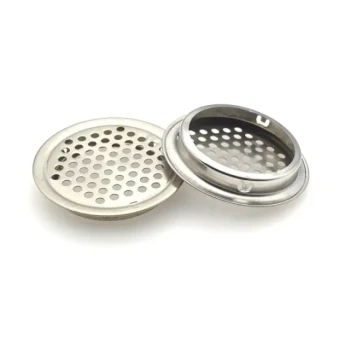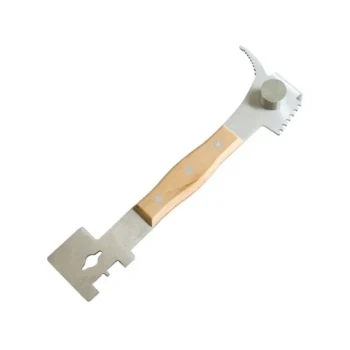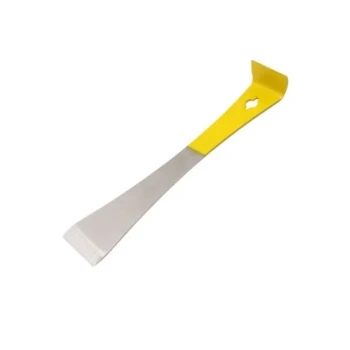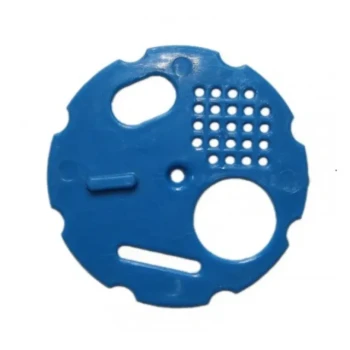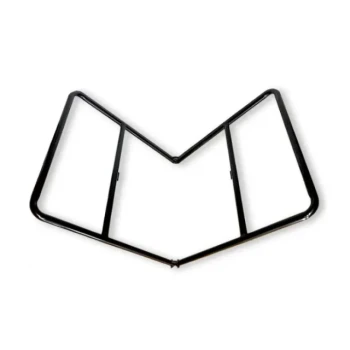At its core, a garden hive lid is the primary shield that protects a honeybee colony from the outside world. Its fundamental purpose is to keep the hive dry, protect it from harsh sunlight, and help the bees maintain the stable internal temperature and humidity crucial for their survival and productivity.
The hive lid is not merely a roof; it is the most critical piece of climate control equipment for the entire colony. Its design and condition directly impact the health, stress, and survival of the bees within.
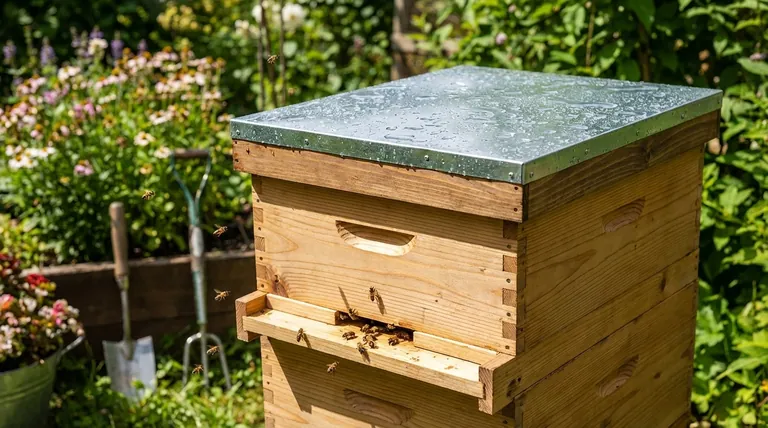
The Lid's Role as a Protective Barrier
A hive's location in a garden exposes it to constant environmental pressures. The lid is the first and most important line of defense against these threats.
Shielding from Precipitation
Rain and snow are significant dangers to a colony. The lid's primary job is to provide a waterproof seal, preventing moisture from entering the hive.
Water inside a hive can lead to chilled brood, spoiled honey stores, and the growth of mold and mildew, all of which can weaken or destroy a colony.
Regulating Solar Exposure
Intense, direct sunlight can rapidly overheat a hive, especially during summer. This forces the bees to expend massive amounts of energy and water just to cool the interior.
A solid, often reflective-colored, lid blocks this solar radiation, helping to keep the internal temperature stable so the bees can focus on foraging and raising young.
Preventing Unwanted Access
A properly fitted lid also serves as a physical barrier. It prevents access by predators like raccoons and pests such as hive beetles or ants that might otherwise try to enter from the top.
A Critical Tool for Internal Climate Control
Beyond simple protection, the lid is an integral part of the hive's ventilation and insulation system, which the bees manage meticulously.
Maintaining Hive Temperature
Bees work to maintain the brood nest at a consistent temperature of around 95°F (35°C). The lid acts as insulation, trapping the colony's warmth during cold weather.
This insulation reduces the amount of honey the bees must consume to generate heat, conserving their winter food stores and increasing their chances of survival.
Managing Condensation and Humidity
In winter, the warm, moist air from the bee cluster rises. When it hits a cold outer lid, it can condense into water droplets that drip back down onto the bees, chilling and even killing them.
A well-designed lid setup, often paired with an inner cover, creates an air gap. This insulating layer helps prevent condensation and allows excess moisture to ventilate out of the hive.
Understanding the Trade-offs
While the term "garden hive lid" often refers to aesthetically pleasing gabled or decorative roofs, the functional principles apply to all lid types.
Gabled Lids vs. Telescoping Covers
A gabled "garden" lid offers excellent water runoff and can be visually appealing. However, its effectiveness depends entirely on its construction quality.
A standard "telescoping" cover, which overhangs the top hive body like a shoebox lid, generally provides superior protection from wind-driven rain and is the most common choice for serious beekeepers.
The Importance of the Inner Cover
Most beekeeping setups use an inner cover directly below the main lid. This thin wooden board provides a dead air space for insulation and has a notch for upper ventilation or feeding.
Using an outer lid without an inner cover significantly reduces its insulating properties and makes hive inspections more disruptive to the bees. The two components are designed to work as a system.
Making the Right Choice for Your Goal
Selecting the right lid depends on your climate, aesthetic goals, and management style.
- If your primary focus is maximum weather protection: Choose a standard telescoping outer cover paired with an inner cover for the best insulation and defense against the elements.
- If your primary focus is aesthetics in a backyard setting: A well-built gabled or garden lid is a fine choice, but ensure it is used with an inner cover to maintain proper climate control.
- If your primary focus is simplicity and low cost: A basic "migratory" lid (a flat board that sits flush on the top box) can work in mild climates but offers minimal protection from rain and requires more careful management.
Ultimately, the lid you choose is a critical investment in the long-term health and security of your colony.
Summary Table:
| Primary Purpose | Key Benefit | Impact on Colony |
|---|---|---|
| Weather Protection | Keeps hive dry, blocks sun | Prevents chilled brood, mold, and overheating |
| Climate Control | Insulates hive, manages humidity | Conserves energy, maintains brood temperature |
| Pest & Predator Barrier | Seals hive from top access | Reduces stress and disease risk |
Protect your investment and ensure your colony's health with the right equipment. HONESTBEE supplies durable, weather-resistant hive lids and complete beekeeping equipment systems to commercial apiaries and distributors. Our wholesale-focused operations ensure you get the reliable gear your bees need to thrive. Contact our experts today to discuss your hive management needs and place your order!
Visual Guide
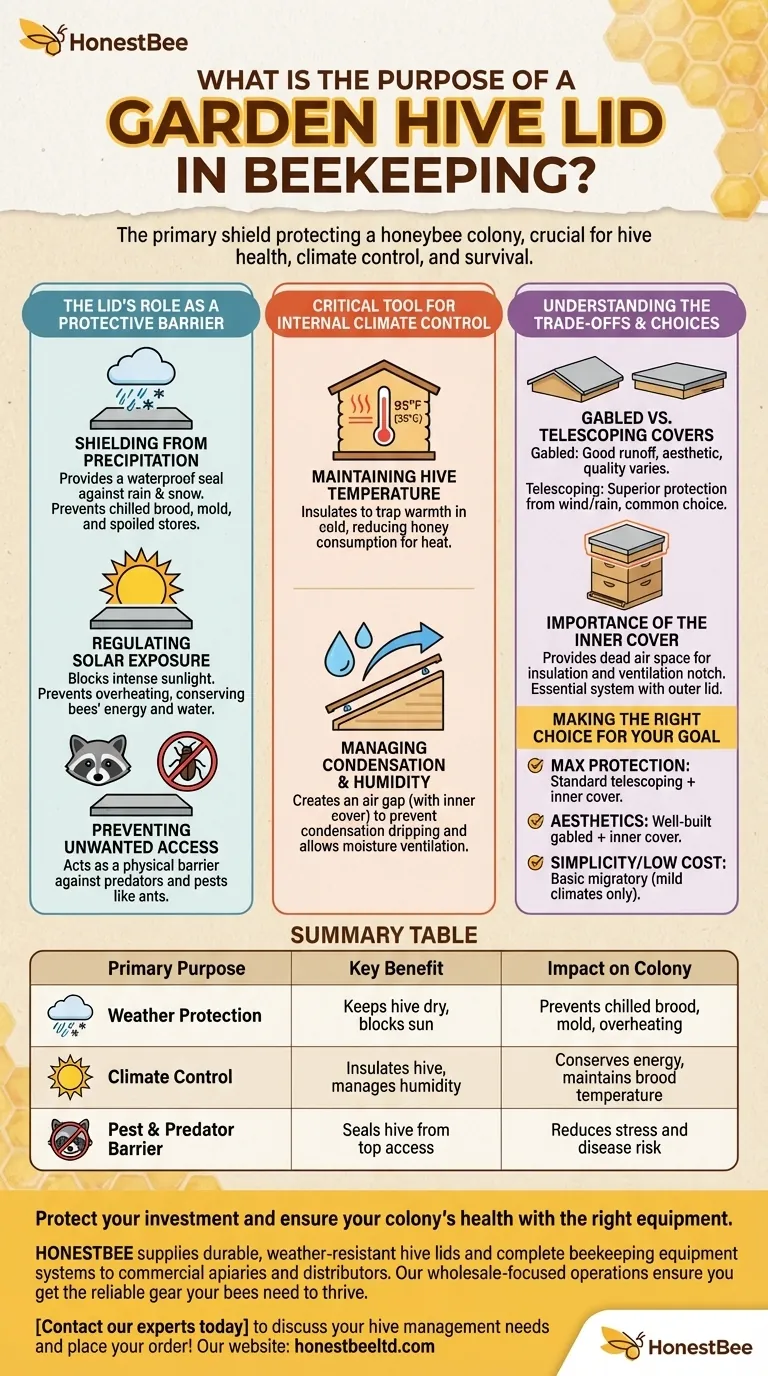
Related Products
- Telescopic Beehive Outer Cover Lid Roof with Galvanised Sheeting for Langstroth Hive and Beehive Outer Cover
- Long Langstroth Style Horizontal Top Bar Hive for Wholesale
- Professional Insulated Winter Hive Wrap for Beekeeping
- Inner Beehive Cover for Beekeeping Bee Hive Inner Cover
- Professional Galvanized Hive Strap with Secure Locking Buckle for Beekeeping
People Also Ask
- What is the function of the top cover in a Langstroth hive? Master Hive Protection & Climate Control
- How can garden hive lids be secured to prevent them from being blown off? | Reliable Methods for Apiary Protection
- What maintenance is recommended for the Langstroth hive roof? Protect Your Hive with Natural Tung Oil
- What is the purpose of the inner and outer covers in a beehive? Essential for Hive Health & Management
- What are the two primary lid styles for Langstroth style beehives? Choose the Right Protection for Your Hives








